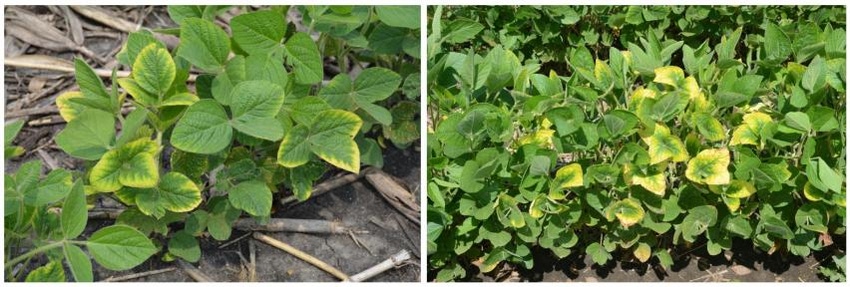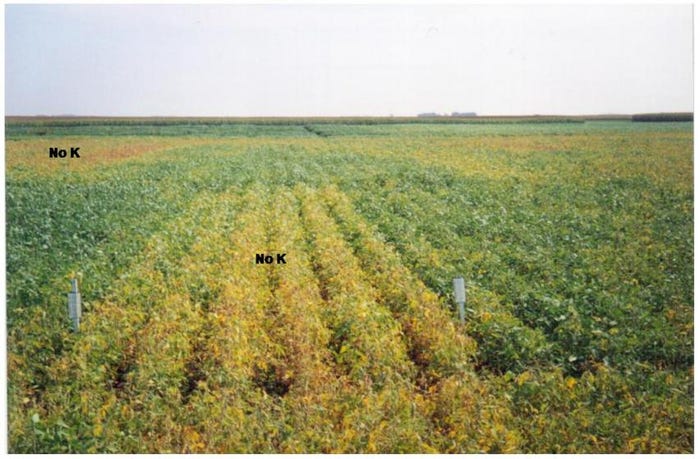August 22, 2018

Source: Iowa State University
Since early August, farmers and consultants have been reporting what they believed were potassium (K) deficiency symptoms in soybean leaves located in the middle or upper canopy. This is not surprising in fields or portions of fields with soil-test values in the very low or low K interpretation categories. Moreover, K deficiency symptoms could develop at these growth stages with drought conditions, even in fields with adequate soil-test K levels. Sometimes symptoms occur in late summer with rainfall events after a dry period. Potassium deficiency symptoms are very common and well known at early growth stages, but due to poorly understood reasons, in the last couple of decades deficiency symptoms in upper leaves at middle to late reproductive stages also have become common.
In low-testing soils or droughty soils, K deficiency symptoms may develop from the V3 stage up to more advanced vegetative stages mainly in the older leaves, but with severe deficiency symptoms may progress to the upper leaves. The symptom is yellowing of the leaflet margins with mild deficiency that may become brown and necrotic with extreme deficiency. The K deficiency symptoms on older leaves sometime remain until the reproductive stages, but often may not be seen because the leaves have been shed or partially decomposed. The reason symptoms are observed mainly in the older leaves at early vegetative growth stages is because K is very mobile within the plant and with a deficiency it is translocated from older leaves to new leaves. Figure 1 shows examples of typical soybean K deficiency symptoms at early growth stages.

Soybean potassium deficiency symptoms at early vegetative growth stages.
The K deficiency symptoms at early vegetative stages should not be confounded with soybean iron deficiency chlorosis (IDC), which often occurs in high-pH (calcareous) soils. In contrast to K deficiency, the IDC symptoms are yellowing of the interveinal area of mainly entire young leaflets. With extreme iron deficiency, however, brown and necrosis may occur in leaf margins. The ICM News article “Is It Iron or Potassium Deficiency?” refers to IDC symptoms in soybean.
The K deficiency symptoms in soybean middle or upper leaves at intermediate to late reproductive stages are similar to the ones observed early in older leaves. Figure 2 shows typical examples of soybean K deficiency symptoms at reproductive stages. The physiological reasons for late-season development of deficiency symptoms during the last couple of decades are not entirely clear. Reasons might be that with increasing soybean yield potential there is more translocation from leaves near developing pods and grain, resulting in deficiency symptoms.

Soybean potassium deficiency symptoms during the reproductive growth stages.
Observations during many years have shown that severe K deficiency can advance soybean maturity. Therefore, it is not surprising to see senescing soybean, with most leaves yellow or brown, in low-testing field areas a few days before plants in other parts of a field. Figure 3 shows and example observed in research plots. It should be remembered, however, that deficiency of other nutrients or conditions such as excessively wet or dry soil also can advance soybean senescence.

Potassium deficiency advances soybean senescence.
Several soybean diseases caused by fungi and viruses can also produce yellowing of soybean upper leaves, which also may advance plant and leaf senesce. Sometimes, the disease symptoms and K deficiency symptoms occur at the same time. This should not be surprising because Iowa research has demonstrated that K deficiency aggravates the incidence or severity of several soybean leaf diseases. Part of this research was summarized in the proceedings article for the 2016 ISU Extension and Outreach ICM conference “Watch potassium management - It also affects corn response to nitrogen and soybean diseases”. Additional field observations suggest possible interactions with soybean cyst nematode (SCN) and aphid infestation levels. That is, upper canopy K deficiency symptoms can develop in field areas associated with SCN or aphids.
Sometimes it is very difficult to distinguish between K or disease symptoms unless the plants or leaves are submitted to a plant pathology lab for study. Soil and leaf K testing of apparently normal and affected field areas also may help identify the cause for the symptoms. Recently published interpretations for K tissue testing can be useful for soybean plants at the V5 to V6 vegetative growth stages or for upper leaves at the R2 to R3 reproductive growth stages, but not for later growth stages. This is because leaf K concentrations decline during later growth stages. You can see the tissue test interpretations in ISU Extension and Outreach publication CROP 3153 “Phosphorus and Potassium Tissue Testing in Corn and Soybean”.
Originally posted by Iowa State University.
You May Also Like




